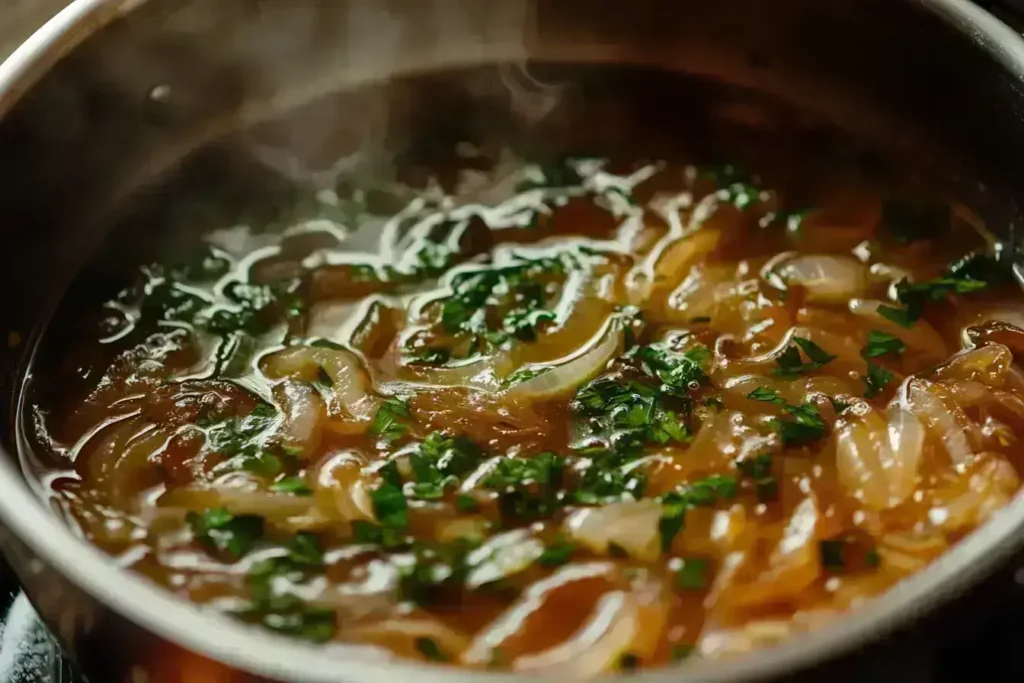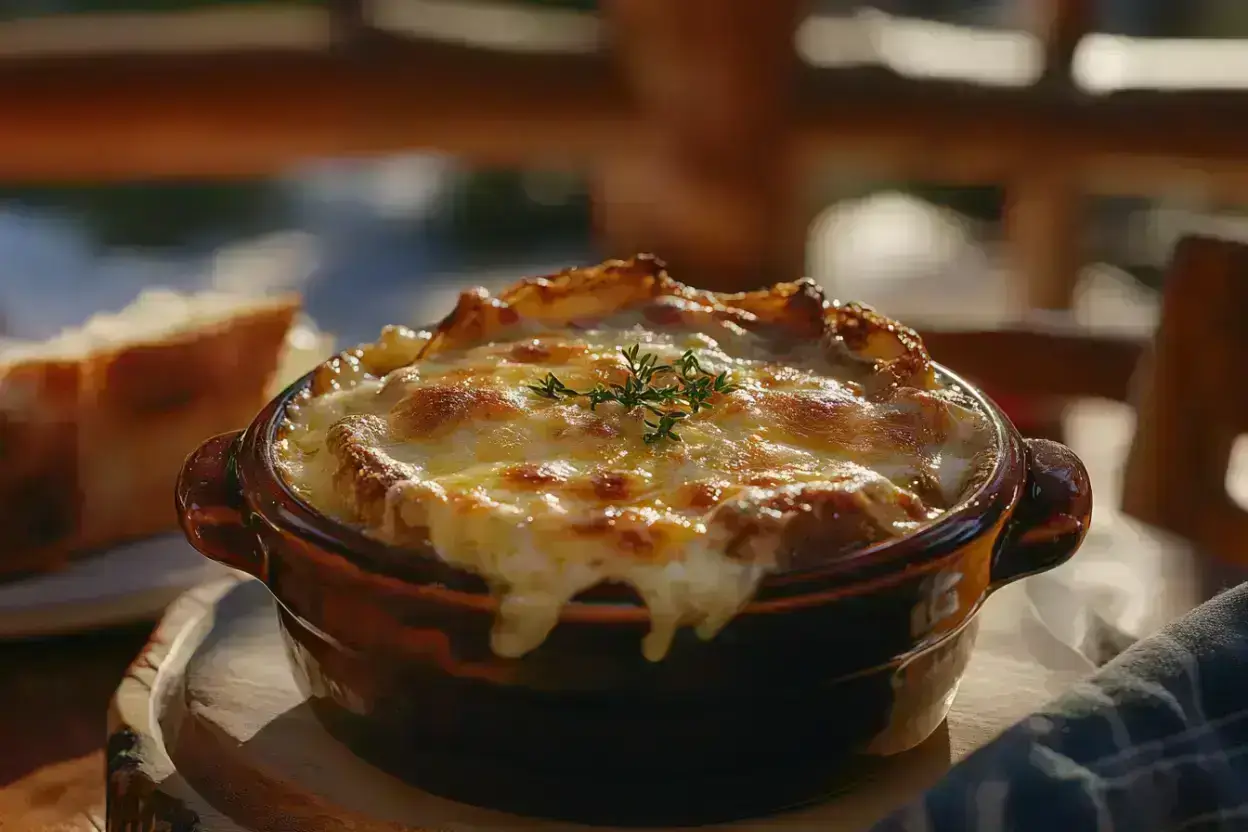There’s something magical about French onion soup, don’t you think? But if you’ve ever wondered how to deepen the flavor of French onion soup to achieve that perfect balance of sweetness, richness, and savoriness, you’re not alone. With the right techniques and ingredients, this classic dish can go from ordinary to extraordinary. Let’s uncover the secrets together.
Understanding the Core Flavors of French Onion Soup
Before diving into tips and tricks, let’s break down the key flavors that define this iconic dish.
Caramelization: The Heart of French Onion Soup
Caramelized onions are the cornerstone when considering how to deepen the flavor of French onion soup. Proper caramelization transforms simple onions into a sweet and savory base, creating a depth of flavor that no shortcut can replicate.
Importance of Quality Broth
The broth is the backbone of your soup. Whether you use beef, chicken, or vegetable stock, its richness and depth will directly impact the final flavor. Homemade broth is always preferred, but a high-quality store-bought option can work in a pinch.
Techniques to Deepen French Onion Soup Flavor
When learning how to deepen the flavor of French onion soup, understanding key techniques like caramelizing onions, deglazing the pan, and choosing high-quality ingredients is essential. These methods ensure every bite is bursting with richness and complexity.
Caramelization: The Heart of French Onion Soup
Caramelized onions are the soul of French onion soup. Achieving the perfect balance of sweetness and depth requires patience and a little finesse.
- Use the Right Onions: Yellow onions are the classic choice for their natural sweetness, but a mix of yellow and red onions can add complexity.
- Cook Low and Slow: Set your stove to medium-low heat, add butter or a mix of butter and oil, and stir often. This process can take 40–60 minutes but is well worth the effort.
- Don’t Rush It: Avoid high heat it can scorch the onions instead of caramelizing them, leaving bitter notes in your soup.
Pro Tip: A pinch of baking soda can speed up caramelization slightly by breaking down the onions’ cell walls. Use it sparingly to avoid altering the flavor.
Deglazing the Pan: Unlocking Hidden Flavors

Once your onions are caramelized, it’s time to unlock the flavorful brown bits (fond) stuck to the bottom of your pan.
- Choose Your Deglazing Liquid: White wine, red wine, brandy, or even sherry are excellent choices. Each adds its unique flavor profile to the soup.
- How to Do It: Pour your liquid of choice into the pan and scrape up the fond with a wooden spoon. Let the alcohol cook off to avoid an overpowering taste.
Why It Works: Deglazing not only adds complexity but also ensures no flavor is left behind.
Using Herbs and Aromatics
Herbs and aromatics are the unsung heroes of French onion soup. They add layers of flavor that balance the sweetness of the onions and the richness of the broth.
- Thyme: Fresh thyme is a classic addition. Tie sprigs together with kitchen twine for easy removal before serving.
- Bay Leaves: Just one or two can add a subtle earthiness.
- Garlic: Minced garlic sautéed with the onions or added during simmering can enhance the overall depth.
- Experiment: Add a touch of rosemary or even a pinch of nutmeg for a unique twist.
The Power of Alcohol: Wine and Brandy
Alcohol, when used correctly, can transform your soup into a restaurant-quality masterpiece.
- Red vs. White Wine: Red wine adds robustness, while white wine offers a brighter, tangy note.
- Brandy or Cognac: A splash of brandy provides warmth and richness. Add it during deglazing or just before simmering.
- Avoid Overdoing It: Too much alcohol can overpower the delicate balance of flavors. Stick to 1/2 cup for a standard recipe.
Pro Tip: If you prefer not to use alcohol, substitute with a mix of apple cider vinegar and beef broth for a similar depth of flavor.
Choosing the Right Cheese and Bread
The crowning glory of French onion soup is its cheesy, crusty topping. The bread and cheese you choose can make all the difference.
- Cheese: Gruyère is the gold standard for its nutty, melty perfection. Comté, Emmental, or a mix of Parmesan and mozzarella can also work.
- Bread: A thick slice of French baguette or sourdough holds up best under the cheese and absorbs the broth beautifully.
- Toast Before Adding: Lightly toasting the bread ensures it won’t turn to mush when submerged in the soup.
Did You Know? In some regions, grated cheese is mixed directly into the soup before adding the bread and topping it with more cheese.
Nutrition Facts and Ingredient Table
Here’s a breakdown of the typical ingredients in French onion soup and their nutritional contributions.
| Ingredient | Quantity | Calories | Key Nutrients |
|---|---|---|---|
| Onions | 6 large | 240 | Fiber, Vitamin C |
| Beef Broth | 6 cups | 120 | Protein, Iron |
| Gruyère Cheese | 1 cup grated | 400 | Calcium, Protein |
| Baguette | 6 slices | 300 | Carbs, Fiber |
| Butter | 2 tbsp | 200 | Fats, Vitamin A |
| Olive Oil | 2 tbsp | 240 | Healthy Fats |
| Red Wine | 1/2 cup | 125 | Antioxidants |
Note: Nutritional values may vary depending on ingredient brands and quantities.
Serving Suggestions and Pairings
Now that your French onion soup is brimming with rich, comforting flavors, it’s time to think about how to serve it in style. Presentation matters, and pairing it with complementary sides can elevate your dining experience.
Perfect Presentation: A Feast for the Eyes
A well-presented French onion soup can be just as satisfying visually as it is to the palate. Here’s how to make it shine:
- Use Individual Bowls: Traditional oven-safe soup crocks or ramekins create an authentic experience and allow for generous cheese coverage on each serving.
- Golden Crust on Top: Broil the soup just long enough to melt the cheese into a bubbling, golden-brown crust. Keep a close eye to avoid burning.
- Garnish Thoughtfully: Add a small sprig of thyme or a sprinkle of freshly ground black pepper to finish each bowl.
Side Dishes to Complete the Meal
French onion soup is hearty enough to stand on its own but pairs beautifully with lighter sides that balance its richness. Consider these options:
- Simple Green Salad: A crisp salad with mixed greens, vinaigrette, and nuts offers a refreshing contrast to the soup’s bold flavors.
- Charcuterie Board: Pair with cured meats, olives, and fresh fruit for a decadent dining experience.
- Steamed Vegetables: Lightly steamed or roasted asparagus, green beans, or carrots bring balance to the meal.
Best Beverages to Serve with French Onion Soup
Pairing the right beverage with your soup enhances its flavors even further:
- Wine:
- Red Wine: A medium-bodied Merlot or Pinot Noir complements the soup’s rich, savory profile.
- White Wine: A dry Chardonnay or Sauvignon Blanc balances the sweetness of the onions.
- Beer:
- A malty brown ale or a Belgian dubbel pairs wonderfully with the earthy, caramelized flavors of the soup.
- Non-Alcoholic Options:
- Sparkling water with a lemon twist or a refreshing iced tea can cleanse the palate between bites.
Frequently Asked Questions (FAQ) About French Onion Soup
What Onions Are Best for French Onion Soup?
The most common choice for French onion soup is yellow onions due to their natural sweetness and ability to caramelize beautifully. However, you can mix in red or white onions for added complexity. Avoid sweet onions like Vidalia, as they may overpower the soup with too much sweetness.
Can I Use Pre-Sliced or Frozen Onions?
While it’s tempting to save time, using pre-sliced or frozen onions isn’t ideal for French onion soup. Freshly sliced onions release their natural sugars during caramelization, resulting in a sweeter and deeper flavor that’s hard to replicate with pre-prepped options.
Is It Possible to Make French Onion Soup Vegetarian?
Yes! To make a vegetarian version, substitute the beef broth with a rich vegetable stock. Add extra herbs and perhaps a splash of soy sauce or miso paste to mimic the umami flavor traditionally provided by beef broth.
How Can I Thicken French Onion Soup?
French onion soup is typically a broth-based soup and not meant to be thickened heavily. However, if you prefer a slightly thicker consistency, you can:
- Add a small amount of flour (about 1–2 tablespoons) during the caramelization process.
- Use a potato masher to break down a portion of the cooked onions, creating a naturally thicker texture.
Why Does My French Onion Soup Taste Bitter?
Bitterness usually results from:
- Burning the Onions: Overcooking onions during caramelization can cause them to develop a burnt, bitter taste.
- Low-Quality Wine: Using a cheap or overly acidic wine can negatively impact the flavor. Stick to a dry wine you’d enjoy drinking.
Solution: Start over with fresh onions or add a teaspoon of sugar or a splash of cream to balance bitterness.
Can I Use Cheese Other Than Gruyère?
While Gruyère is the traditional choice, you can experiment with alternatives like:
- Comté or Emmental: Nutty and melty, similar to Gruyère.
- Mozzarella and Parmesan Mix: For a more accessible and cost-effective option.
- Cheddar: Adds a tangier, sharper flavor twist.
Why Is My Soup Too Salty?
If your soup ends up too salty:
- Add a potato: Peel and cut a potato into chunks, simmer it in the soup to absorb excess salt, then remove it before serving.
- Dilute with unsalted broth or water.
- Balance the flavor with a splash of vinegar or lemon juice.
How Can I Make the Cheese Topping Crispier?
To achieve a perfectly crisp and gooey cheese topping:
- Use a generous amount of cheese to fully cover the bread and edges of the bowl.
- Place the bowls under the broiler on the top rack and monitor closely to avoid burning.
Can I Make French Onion Soup Gluten-Free?
Yes! To make a gluten-free version:
- Replace the bread with gluten-free options like a slice of gluten-free baguette.
- Ensure the broth you’re using is certified gluten-free.
What Can I Do with Leftover French Onion Soup?
Leftover soup can be repurposed creatively:
- Sauce Base: Use it as a sauce for roasted meats or baked pasta.
- Stew Enhancer: Add it to other soups or stews to deepen their flavor.
- Freeze for Later: Portion it into freezer-safe containers for quick meals.
Conclusion and Final Tips
French onion soup is more than just a dish it’s a celebration of simple ingredients transformed into something extraordinary. By focusing on techniques like proper caramelization, deglazing, and using high-quality ingredients, you can create a soup that’s rich, flavorful, and deeply satisfying.
Before you start cooking, take a moment to prepare your all ingredients and tools to make the process seamless and enjoyable. Remember, good food takes time, but the results are well worth the effort.
Ready to try your hand at other comforting recipes? Explore more on Saison Recipes for inspiration.

